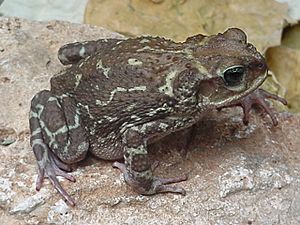Peltophryne peltocephala facts for kids
Quick facts for kids Peltophryne peltocephala |
|
|---|---|
 |
|
| Conservation status | |
| Scientific classification | |
| Synonyms | |
|
Bufo peltocephalus Tschudi, 1838 |
The Peltophryne peltocephala is a special kind of toad that lives only in Cuba. It's often called the Cuban toad or Tschudi's Cuban toad. This toad belongs to the family Bufonidae, which includes many different types of toads.
You can find this toad in the central and eastern parts of Cuba. It also lives on some smaller islands nearby. The Cuban toad likes to live in many different places. These include forests with broadleaf trees, open grasslands, savannas, and even farm areas. It's a common toad in Cuba, but its homes are sometimes threatened by human activities.
Contents
Meet the Cuban Toad
The Cuban toad is a fascinating amphibian. Like all toads, it has bumpy skin and strong legs for hopping. Toads are different from frogs because they usually have drier, rougher skin. They also spend more time on land than in water.
What it Looks Like
Cuban toads have colors that help them blend in with their surroundings. This is called camouflage. Their skin might be shades of brown, gray, or olive green. This helps them hide from animals that might want to eat them. They also have large eyes that help them see well, especially at night.
Where it Lives
This toad is endemic to Cuba. This means it is found naturally nowhere else in the world. It lives in many different types of places, called habitats.
- Broadleaf forests: These are forests with trees that have wide, flat leaves.
- Grasslands: Open areas covered mostly with grasses.
- Savannas: Areas with tall grasses and scattered trees.
- Agricultural areas: Farmland where crops are grown.
This toad can adapt to different environments. This helps it survive in many parts of Cuba.
What it Eats
Cuban toads are carnivores, meaning they eat other animals. They are important for controlling insect populations. They usually eat small invertebrates.
Toads wait quietly for their prey to come close. Then, they use their long, sticky tongues to catch their meal quickly.
Life Cycle and Reproduction
Like most amphibians, Cuban toads start their lives in water. Their life cycle has several stages.
- Eggs: Female toads lay their eggs in water, often in long strings.
- Tadpoles: The eggs hatch into tiny tadpoles. Tadpoles live in water and breathe with gills. They look like small fish and eat tiny plants or algae.
- Metamorphosis: As tadpoles grow, they go through a big change called metamorphosis. They develop legs, their gills disappear, and lungs grow. Their tails also get shorter.
- Adults: Once they are fully developed, young toads leave the water. They then live mostly on land. They will grow into adult toads and can then reproduce themselves.
Staying Safe
Toads have ways to protect themselves from predators. Their bumpy skin can sometimes release a mild toxin. This makes them taste bad to animals that try to eat them. This is a defense mechanism. It helps them avoid becoming a meal for snakes, birds, or other animals.
Why the Cuban Toad Needs Our Help
Even though the Cuban toad is common, it faces some challenges. The biggest threat is habitat loss.
- Development: As human populations grow, more land is used for buildings and roads. This takes away the toad's natural homes.
- Farming: Expanding farms can also reduce the areas where toads can live.
- Pollution: Chemicals used in farming can harm toads and their water sources.
Protecting their habitats is very important. This helps ensure that the Cuban toad can continue to thrive in Cuba for many years to come.
See also
 In Spanish: Peltophryne peltocephala para niños
In Spanish: Peltophryne peltocephala para niños


